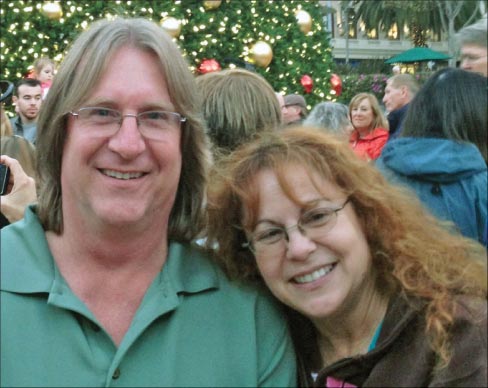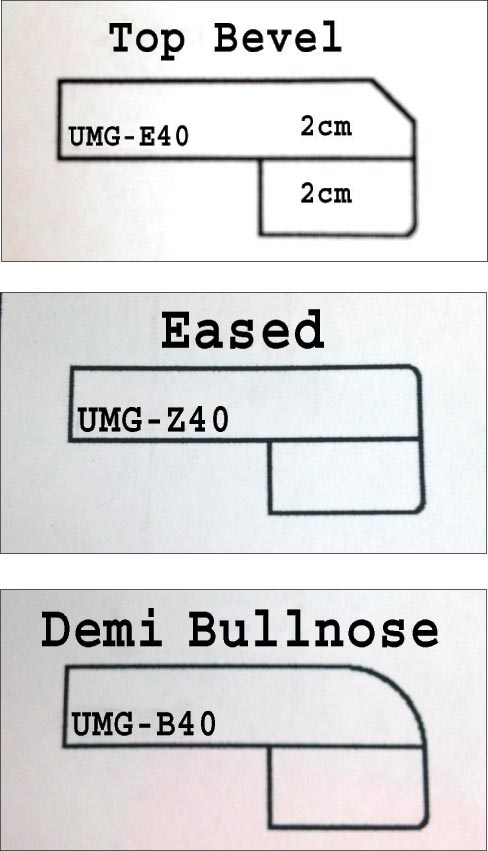The “Husband Edge”
Jodi Wallace
Special Contributor
 My husband Ken and I own a small shop and showroom in San Jose, CA. One of my (but not limited to) pet peeves with designers and architects is that they do not always take into consideration how customers use the products we install for them with regard to edge profiles.
My husband Ken and I own a small shop and showroom in San Jose, CA. One of my (but not limited to) pet peeves with designers and architects is that they do not always take into consideration how customers use the products we install for them with regard to edge profiles.
 An occupational hazard of owning our own business is that I check out surfaces and people using those surfaces constantly. It used to drive my son crazy when we would be out somewhere and he would find me “petting” the countertop and seams!
An occupational hazard of owning our own business is that I check out surfaces and people using those surfaces constantly. It used to drive my son crazy when we would be out somewhere and he would find me “petting” the countertop and seams!
For me, there is nothing more frustrating than going to a potential customer’s home to bid on bathroom surfaces and as we inevitably walk by the kitchen, asking the home owner, how did they like their countertops? I was shocked at the number of times I would look at kitchens with $5,000, $6,000, $7,000 or more worth of gorgeous stone and have a response of, “It’s alright.”
Seriously? For me, if my customers don’t say they absolutely love their countertops, I have not done my job correctly. In fact, anyone who has done business with us will tell you I will not sell a customer a color they look at and deem “just alright.” If your appraisal of that choice is that it is “just alright,” we keep looking until we find one and they go, “Wow, I really like that one!” Now, that is the right choice.
In most cases when I asked a few more questions, it turns out that although achingly large amounts of time were spent picking out the stone, when it came to edge profiles, customers were generally shown a paper and told “pick one,” or hurriedly shown an edge board and told, “Point to what you want.” In my book– that’s a huge mistake.
At 4´–11-¼˝, (stop laughing!) I am very conscious of how an edge feels when I touch it, lean against it, or run my hand over it. I consider the choice of an edge detail just as important as the choice of design or color.
Since I am the one who runs our showroom, I spend a lot of time with my customers on what I call “Countertops 101,” (more on this at a later date). Although I may allow a husband or boyfriend to zone out when we are looking at colors, discussing sinks, splash options, etc., when it comes to edges, they are drawn back into the conversation willingly, or on occasion, with a nudge in the ribs, (by me!) to pay attention!
Edges are more than just a passing detail. At our shop, I rarely sell fancy, upgraded edges. I do have an edge board which shows what’s available, if a customer specifically asks, but the displays in our showroom all have simple, clean edges.
To me, an edge detail should be an almost extension of the countertop, helping to draw the eyes upward to the top surface, complimenting, but not competing with the countertop. My best example is a brochure from one of the very popular quartz manufacturers. The picture shows an extremely busy and bright-patterned color choice with an extreme 6cm Waterfall edge. The color and edge are in so much competition with each other that neither can catch your full attention. It comes across heavy and disconnected.
In our showroom, customers must touch, as well as aesthetically judge each edge. I believe an edge serves two purposes. The first is to compliment, but not take away from the countertop. Secondly, and even most importantly, an edge must prove the correct “feel” to the surfaces, based on how it will be utilized.
Our shop offers four standard edges, all priced the same. We feel it important a customer choose their edge based on comfort level and what they like, and not because it is the cheapest. It is a package deal and both the edge and color/pattern must work together to provide a seamless and harmoniously final product.
An Eased edge seems to be most for that contemporary and “square” look. Although it does provide a “clean” line, Eased does not rank high on the “comfort” scale and has a definite sharpness to the touch. For customers coming in seeking that look, especially if they have children, I show them not only an Eased edge, but another not quite as square, and more comfortable to the touch.
A Double Roundover is another simple edge, which across the room provides that “thick, square” look people are seeking, but is softer to the touch then an Eased. My most popular is the 3/8˝ Double Roundover, top and bottom. Few shops out here I know of offer this edge, instead choosing only to offer the Eased. I do so many jobs with this edge that one of the other shops we are good friends with added it to their edge offerings.
For those with an island or peninsula who intend to have bar stools and want to be able to sit with a book or cup of coffee, or who have small children who will be leaning on the edge to do homework, the “Double Roundover” offers a simplistic square look but with a comfortableness to it that cannot be found with an Eased.
Our third offering is a Bevel. Although a bit sharp, the ¼˝ bevel offers a small accent and interest point to an edge, again without competing with the countertop itself, which should stay the focal point.
Our final choice is a Demi-Bullnose, the “softest” of our standard edges. Not to be confused with a full Bullnose, which I only rarely do in commercial applications, our Demi-Bullnose has a ¾˝ radius on top, and is flat and polished on the bottom. Soft, smooth on both the top and bottom, it offers a simplistic look with a high comfort level to it. In the last year the amount of jobs I am doing with this edge is rivaling our Double Roundover. Why? Because I make my customers feel each edge, lean against it, take it for a test drive.
This pertains to men in particular, who are usually left out of the edge discussion at other shops. Men tend to lean with their backs against a counter edge, the heels of their hand (or hands) putting their weight on the edge. (I can see all the men stopping to give thought to how they stand about now!)
The taller the guy, the more he leans on the edge. Many times when I mention this, a wife will go, “Really? I haven’t heard of that,” and suddenly you can see the wheels in the husband’s brain spinning as he says, “Yeah, I never thought of that, but you’re right.”
At that point the guy becomes very engaged and starts walking around touching and evaluating all the edges. I have wives all the time turn and whisper, “I practically had to drag him here. I can’t believe this!”
I have started selling so many jobs with the Demi-Bullnose as the edge of choice that I jokingly told a couple a few months ago I was going to start referring to this as my “husband edge.” We laughed about it and I didn’t think much more of it.
Several weeks later I was in LA getting ready for our daughter’s wedding when my husband (who was working the showroom) called me on my cell in a slightly irritated voice and asked me what exactly the “husband edge” was, as he had a couple standing with him that had come saying they had met with me previously and wanted the “husband edge” as their final choice. He (obviously) had no clue what they were talking about and since they couldn’t remember which one it was, he had to call me.
It took me a minute to wrap my head around the question, let alone the answer, but when I realized what was going on I quickly told him what happened and why I had called it that. Considering the showroom was very busy at the time, I’m not quite sure he saw the humor in it!
My motto is that I will put in whatever a customer likes, and when we leave, it is theirs to live with forever. But I also believe we are the educators of our customers. Just because it looks good in a magazine or website doesn’t mean it is the best choice for our customer. It is up to us to make sure the final fit is perfect for their needs. That is the mark of a good shop.
Jodi Wallace is co-owner of Monarch Solid Surface Designs in San Jose, California. She may be reached at monarchssdesigns@aol.com.